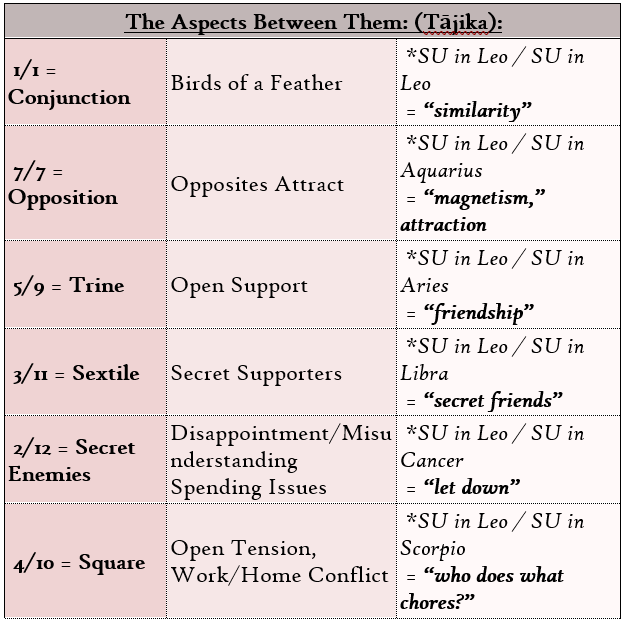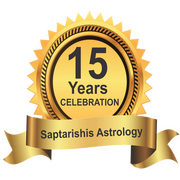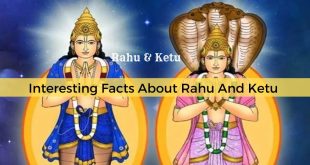Related Articles
INTRODUCTION TO COMPATIBILITY
By
Simon Chokoisky
Part 1
There is a difference between relationship viability and a couple’s compatibility. The first describes a relationship’s ability to survive. The second tells us whether two people in that relationship actually like each other. This goes for any kind of partnership – business, friendship, dating, or marriage.
Jyotisha’s methods tend to measure relationship viability – whether a marriage will last. Jyotisha seems to show less concern for whether couples actually get along on a personality level. This is more the purview of Western synastry techniques, which look at the inter-relationship between SU, MO, VE, MA, and the Lagna to find out whether couples fulfill each other on the personality and emotional level. Carl Jung published statistical research showing the results of such planetary interrelationships in the charts of married couples.* Techniques like these focus primarily on love and passion rather than whether the relationship will last.
Traditional cultures were more concerned for a family’s welfare and survival than its day-to-day happiness. This means they focused on prosperity, children, health, and the family’s ability to contribute to society. Not surprisingly, Jyotisha’s main compatibility measurements, the kutas, emphasize these big themes, while synastry goes after finding happiness and fulfillment, whatever the relationship outcome. Ultimately, we need both approaches in order to match couples for long-term, harmonious relationships.
For example, let’s take the Yoni kuta, which governs sexual compatibility. This is calculated by finding the ruling animal of your moon nakshatra, as illustrated in the chart below. In most ashtakuta systems, Yoni gets about four points out of 36 total. The threshold for a workable relationship is having 18 or more points after adding all eight kutas. That means that if the other scores mainly agree, good compatibility can easily exist between a couple even if there is zero Yoni kuta compatibility.
However, in modern times, an unfulfilling sex life can be a relationship dealbreaker. For that reason, among others, it’s important to understand what each person wants in a relationship before looking at their kuta scores. Also, there is a third leg to the compatibility stool: the Personal Handicap. Along with relationship viability, and compatibility, we must consider each person’s karmic propensity for successful relationships, as well as the relationship skills they bring to the table.
Barbara Bush (former first lady to George Bush Sr.) had such an impressive personal handicap, (or as I call it, Relationship Credit Score) that any man she married would have become successful. Any groom she chose would have become a better man, because her own chart is set up to bring out excellence in a mate. The techniques for finding this are beyond the scope of this article, but it’s enough to say that such horoscopes are few… as are their opposites – charts with a very poor Relationship Credit Score that can bring down a potential partner.
Thus we have three legs to the Relationship stool:
Personal Handicap – Relationship Viability – Relationship Compatibility
Ideally, all three must align for a perfect partnership – be it business, friendship, dating, or marriage. We must have people with good skills and relationship karma, as well as good compatibility and viability scores. So how do we do this?
Let’s begin with relationship viability, as this is practically measured by the ashtakuta or dashakuta methods in Jyotisha, including ancillary techniques like Kuja dosha, vadha vainashika, mahendra, and rajju/vedha. Most Vedic astrologers are familiar with these, but have traditionally only used the moon to measure them. In his book Light on Relationships,* Hart deFouw proposed analyzing kuta scores from the Lagna as well.
This presents scenarios where a relationship may look strong from the moon (18 or more points in the ashtakuta), but reveals a fundamental weakness if its lagna kutas score is low (below 18 points). For example, a couple with 24 moon ashtakuta points may think their relationship is on solid ground, but should that couple have only 6 points from their Lagnas, they may be in store for unexpected earthquakes if they decide they marry.
So what’s the difference between the Moon and Lagna kutas? Let’s continue the Yoni example. A couple with a strong score from the moon is likely to find their sex life fulfilling, all other factors being equal, whether they have sex once a day or once a month. A strong Moon score suggests a lasting, positive emotionall rasa with respect to the sex life,. They are satisfied, regardless of whether the actual sex act is satisfying or orgasmic.
The lagna Yoni score, on the other hand, measures the immediate physical pleasure derived from sex. Thus, a couple with excellent lagna Yoni may find that they have great sex in the moment, but if there is no Moon Yoni harmony, those good feelings may not last. The reverse is also true. A great Moon score may give overall satisfaction, but a poor lagna score could show sexual mismatching, different tastes, or other obstacles to physical fulfillment.
Thus, in relationships where sexuality is a primary consideration, look for at least two or more Yoni kuta points from both MO and the lagna. And for excellent overall relationship viability, look for scores of 24 ashtakuta points and above from both MO and lagna. This is higher than the accepted 18 points, but since we’re matching couples for life, it’s important that they find the best possible partner.
Of course, we have to look at synastry methods as well in order to complete the picture, and thereby determine if the fire will last seven minutes, seven lifetimes, or something in between. Thus, combining the ancient methods of relationship viability with modern methods of relationship compatibility can give us a complete picture of the relationship landscape. Synastry combos together with the Kutas can match couples who not only stay together, but play together.
Part II
Having looked briefly at viability, or what I call the Ancient Methods, let’s now examine major compatibility factors using the Modern Methods. These begin with the four cornerstones – the SU, MO, VE and Lagna. We start by comparing the cornerstones to each other – my SU to your SU, my MO to your MO and so forth. If these are in a positive Tajika aspect to each other, they create harmony. Negative aspects do the opposite. We use whole sign aspects with no orb requirement, though the tighter the orb, the more intense the aspect, for good or ill. See the table below.


For compatibility purposes, the positive aspects are the conjunction (1/1), opposition (7/7), trine (5/9), and sextile (3/11), in descending order of strength. If at least two of the cornerstones are in a positive aspect, this creates harmony between a couple on the level of:
SU – values, religion, politics, soul, philosophy
MO – emotions, likes/dislikes, domestic comfort
VE – romance, sensuality, desire for each other, enjoyment of life
LG – physicality (body), life circumstances, habits, personality
For example, the long-time couple Goldie Hawn and Kurt Russell have all four cornerstones aligned: their MOs by occupying the same rashi (conjunction), their SUs by trine, and their LGs and VEs by opposition. This is helped by the fact that two of these are also very close by orb, making it an especially strong mutual connection. Tight orbs intensify aspects- for good or bad- making positive aspects more desirable, and negative ones more difficult.
Cornerstone analysis is the first step to analyzing compatibility with the Modern Method. Next we analyze soulmate indicators, which are specific combinations for attraction and attachment. These include the inter relationships between SU, MO, VE, LG and MA. For example, my VE to your SU, or your MA to my MO. Here are some of the combinations that regularly appear in the charts of married couples:
MO/MA- A conjunction of one person’s MO to the other’s MA is one of the strongest synastry indicators for long-term passion in a relationship. As noted above, the closer the orb, the more intense the combination. This can happen two ways: his MO to her MA or her MO to his MA. Either way, it is desirable in modern synastry, but especially if the woman’s MA conjoins the man’s MO. This is because for a man, VE and MO represent his feminine ideal. The first, VE, usually earlier in life, and the MO later as he is ready to settle down. When a woman’s MA, SU, or LG conjoin or oppose the rashi containing a man’s MO (and VE) this creates attraction for him. That is, she activates what he perceives as beauty (VE), and nurturing (MO). From this we can extrapolate further combinations for attraction:
Woman’s to Man’s
MA MO, VE
SU MO, VE
LG MO, VE
We can go in reverse as well, as MA defines a woman’s ideal in a man:
Man’s to Woman’s
SU MA
LG MA
MO MA
These are all part of the “Soulmate Indicators” proforma we teach in our Divine Love Masterclass. By putting these together in a comprehensive Compatibility Protocol, we can arrive at a systematic interpretation of a couple’s potential compatibility. The key is, you don’t need to have all or even most of these. It only takes one, well-placed combo to spark a life-long relationship, provided other relationship factors discussed in this article are also in place.
Let’s say that again: it only takes one powerful soulmate combo to spark a life-long relationship. What makes a combo powerful? Consider tight planetary orbs, planetary dignity by rashi, as well as the planetary house placement in each partner’s chart.
This brings us to another important technique for measuring what each partner means to the other. If person A’s planets activate houses I and VII for person B, then person B will consider person A relationship material. If this is mutual, we have the foundation for a long-term relationship. We can extend the relationship houses to bhavas I, V, VII, and even VIII if sexuality is especially important, since bhavas V and VIII rule flirting, dating and sex. Furthermore, we can add bhavas II and XI as they rule family and desire fulfillment, respectively.
On the other hand, should two partners only bring out houses VI, X, and XI for each other, for example, they may find themselves quite suitable as coworkers, but should they venture down the tunnel of love, they may find the journey far more work, than play.
There are many such combinations to consider, but to conclude this section, let’s look at the often overlooked factor of timing. Indeed, one of the strongest binding techniques in matchmaking relies solely on a couple’s timing. It is called sama dasha – when two people run the same dasha together, ideally no more than two to three years apart.
Such couples will find that they stay together, whatever their ups and downs. And while such timing is rare, we can extrapolate the sama dasha technique to look at how a couple’s dasha lords interrelate. For example, if you’re running SA dasha and I’m running SU dasha, there may naturally be tension between us, whatever our compatibility otherwise. Furthermore, should my SA and your SU also sit six/eight to each other by rashi position, that would further complicate an already inimical pairing, making it ever more toilsome to resolve the natural enmity between SA and SU. However, should these grahas sit 5/9 to each other, the natural enmity may very well be mitigated by their agreeable mutual position.
Thus, there is more to matchmaking than simple guna milan, or kuta agreement. Neither does Western synastry have all the answers. We need a comprehensive system that incorporates all of these factors, including timing and personal handicap, to judge whether two people truly belong together. And even then, we can only ever hope to be partly correct. As the saying goes, you cannot take the square root of a sonnet. Love, life, and our experience of it, is impossible to fully quantify.
Part III
Summary of Dealmakers
Below are some of the methods that create lasting relationship bonds between two charts. This list is not exhaustive, but summarizes the above article into usable techniques. All combos are seen between two charts, not within a single horoscope.
MO-MA conjunction, especially when it is the woman’s MA on the man’s MO. But both ways work to create lasting passion and closeness in a relationship.
SU-MO conjunction or opposition. This is the classic “soulmate combo” eulogized in synastry books. It works in any type of relationship and is also seen in family dynamics, like mother-son or brother-sister. It is more general in nature, unless the degrees are very close.
Tight orb positive aspects. The previous combinations, along with other, lesser-valued combos, can yield powerful results if the planets involved are within five degrees or so. This amplifies the effects of the two planets and reflects in the closeness of the partners to each other, sometimes making them literally ‘inseparable.’
I-VII House emphasis. When each partner’s planets emphasize the other’s first or seventh houses, this focuses the relationship on partnership. The full list of marriage houses can be extended to 1-2- 5-7-8-11.
Strong ashtakuta scores from MO and Lagna. When both are 24 points or higher, this shows greater likelihood of long-term success, all other factors being equal. The normal 18 point threshold is not good enough when it comes to modern relationships where partners have more choice and less patience!
Strong Core Connection. When your four cornerstones MO, SU, VE, LG match harmoniously, you will tend to get along well, whatever the relationship.
Sama Dasha. Perhaps the most powerful combination, and one not dependent on other compatibility techniques, is for two people to run the same dasha together within up to about two and a half years difference.
For more information, go to to avail of the complete software for calculating the complete Compatibility Protocol, including Ancient and Modern methods.
Carl Gustav Jung, Synchronicity: An Acausal Connecting Principle, from The Collected Works of C.G. Jung, Vol VIII, Bollingen Series XX. Princeton University Press 1960
* Hart deFouw and Robert Svoboda, Light on Relationships: The Synastry of Indian Astrology. Samuel Weiser, Inc, 2000
Learn Astrology: Join Our Upcoming Astrology Classes — Click Here
Learn Astrology: Join Our Recorded Astrology Classes — Click Here
 Saptarishis Astrology Magazine Into Creating Astrologers
Saptarishis Astrology Magazine Into Creating Astrologers






